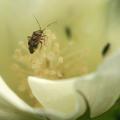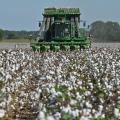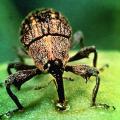Fall Armyworms
“That field looked fine when I drove by it Wednesday afternoon, but when I came back to cut it on Saturday it was nothing but stems!”
Fall armyworm, Spodoptera frugiperda, is the most damaging insect pest of bermudagrass hayfields. These caterpillars can destroy an entire cutting of hay in just a couple of days. The reason for this rapid crop loss is that the caterpillars do 80 to 90% of their feeding in the last two to three days of their life. During the summer months fall armyworms remain in the caterpillar stage for around 10 to 14 days, but young caterpillars eat very little, and their damage is easy to overlook.
By the time they are ¾ to 1 inch long fall armyworm caterpillars are leaf-eating machines that rapidly consume large amounts of leaf area. Multiply the leaf consumption of a single caterpillar by the hundreds of thousands of caterpillars per acre that occur during heavy outbreaks, and it is easy to understand how fall armyworms can cause such rapid defoliation. This is why experienced cattlemen and hay producers learn to scout their fields every two to three days during periods when fall armyworms are a threat and to have their spray equipment ready to go.
See Extension Publication 2717, Fall Armyworms in Hayfields and Pastures for fall armyworm treatment recommendations and information on fall armyworm biology and how to best protect bermudagrass hayfields from this damaging pest.
Contact
Dr. Blake Layton, Extension Entomology Specialist
Department of Entomology, Mississippi State University
Phone: (662) 325-2085
Email: blayton@entomology.msstate.edu
Publications
News
Insect pests are ongoing issues in row crop farming, and deciding when, how and whether to treat is never a simple decision.
Offered by the Mississippi State University Extension Service, the Row Crop Short Course in December featured sessions informed by MSU’s ongoing research that helps growers make management decisions. Several sessions addressed insect control from a variety of angles.
STARKVILLE, Miss. -- Agricultural producers and consultants are encouraged to register for the annual Mississippi State University Row Crop Short Course.
The tarnished plant bug is Mississippi’s No. 1 most economically damaging insect in cotton, costing an estimated $42 million in yield losses plus millions more spent to control the pest.
Success Stories
When Mississippi achieved statehood in 1817, its cotton industry was only beginning to take off. By 1917, boll weevils were devastating the state’s cotton crop and its economy.






